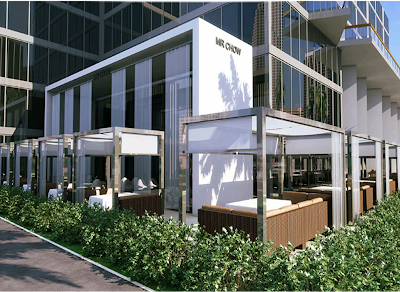China has such a powerful tradition that varies in age, size, and influence especially with their religions. The two main religions are Confucianism (based on ethical teachings of Confucius 551-479 B.C.) and Buddhism (introduced from India c. A.D. 90). 3 Confucian fundamentals of Chinese morality: reverence, responsibility and humanity. The Chinese cosmological principle of the
yin and
yang which symbolizes all things opposing, is related to
feng shui meaning "wind and water", although it has been called ''the art of placement". It's application can affect the orientations of buildings, building elements, and furniture.
**NOTE: 4000 B.C. - A.D. 1912. "The reality of the building consisted not in the four walls and the roof, but in the space within" Lao-tzu, born c. 600 B.C., the founder of Chinese Taoism, another Chinese religion.
**Around the time the Great Pyramids were being built in Egypt, China was already using the potter's wheel making bronzelike alloys of copper and lead, and building large meeting houses of timber with thatched roofs.
**Chinese design known for putting furniture around the perimeter of room, as well as modular buildings. Did not use glue only mortise and tenon joinery.
***NOTE: China known for porcelain, earthenware, stoneware, grey terra-cotta, metal work, textiles, and hanging silk rugs.
 Ming dynasty: Chinese history, like Egyptian had rulers and one of them was Hsia, many of the art was produced around this era of the Ming dynasty (1368-1644). This is a porcelain flask with blue underglaze decoration, c. 1430.
Ming dynasty: Chinese history, like Egyptian had rulers and one of them was Hsia, many of the art was produced around this era of the Ming dynasty (1368-1644). This is a porcelain flask with blue underglaze decoration, c. 1430.
Temples and Pagodas: Two distinctive types of Chinese religious buildings only available in the East.
 Temple: one example of modular, axial assemblage of bays into a skeleton form of construction, with regular spaced columns providing support for the roof. Roofs often faced with glazed tile, sometimes in bright colours. * Often seen as a complex with a gate for privacy, a forecourt, and a passage to the axial gate.
Temple: one example of modular, axial assemblage of bays into a skeleton form of construction, with regular spaced columns providing support for the roof. Roofs often faced with glazed tile, sometimes in bright colours. * Often seen as a complex with a gate for privacy, a forecourt, and a passage to the axial gate.
 Pagodas: it is possible that the chattra-topped stupa of India may have led to the Pagoda of China. The pagoda can also be seen with a combination of watch towers of the Han dynasty. Pagodas were built out of wood, stone, or brick with the roof elements faced with tile.
Pagodas: it is possible that the chattra-topped stupa of India may have led to the Pagoda of China. The pagoda can also be seen with a combination of watch towers of the Han dynasty. Pagodas were built out of wood, stone, or brick with the roof elements faced with tile.
The Forbidden City:

Greatest Chinese temple complex, under the reign of Ming emperor Ch'eng Tsu (1403-25), located in Beijing. Called the Forbidden City for it was forbidden to all but members of the imperial household and their servants and guests.

The Hall of Supreme Harmony: the main hall in the Forbidden City c. 1406. The stairs lead to the ceremonial throne.
Furniture:
 Rosewood chair:
Rosewood chair: includes a
slat (horizontal member across the top of its back) and a
splat (central or vertical member at the back). These chairs were originally intended for emperors or high officials with gold or brass projections decorated with dragon's heads. 16- 17 th century Ming Dynasty
Just beautifully curved with a slightly projecting
crest rail/ slat. Rosewood Chair: horseshoe (back) shape continuing down to form an arm and continuing even further to become the front leg with an apron just under the seat. Ming dynasty 17 th century.
Rosewood Chair: horseshoe (back) shape continuing down to form an arm and continuing even further to become the front leg with an apron just under the seat. Ming dynasty 17 th century.
 K'ang bed frame:
K'ang bed frame: 6 vertical posts supporting a tester. Built of wood with a "low to the ground" design.
K'ang table: eventually the K'ang platform (canopy) evolved into a table. Main characteristic detail is the leg that curves gracefully inward to form a "horse's hoof".
Chinese Screens:

Ornate with flowers and swirls.

Flowers with picturesque setting with Geisha girl.

Lattice work with each panel.
With trees and birds, this screen looks like a silk screen print.
NAMI is on that Confucius tip!!!!

 Mexican style home with terra-cotta roof tiles. beautiful landscaping; very important.
Mexican style home with terra-cotta roof tiles. beautiful landscaping; very important. Dining Room. Very nice. Love the stone feature wall, curved arch ways and the lighting. Art always a must!!!!!! Especially Cubism!!! Comfortable dining chairs for long stays.
Dining Room. Very nice. Love the stone feature wall, curved arch ways and the lighting. Art always a must!!!!!! Especially Cubism!!! Comfortable dining chairs for long stays. Kitchen. Fabulous, I love the chairs, the back splash and the cabinetry. All in the life as a designer!
Kitchen. Fabulous, I love the chairs, the back splash and the cabinetry. All in the life as a designer!












































